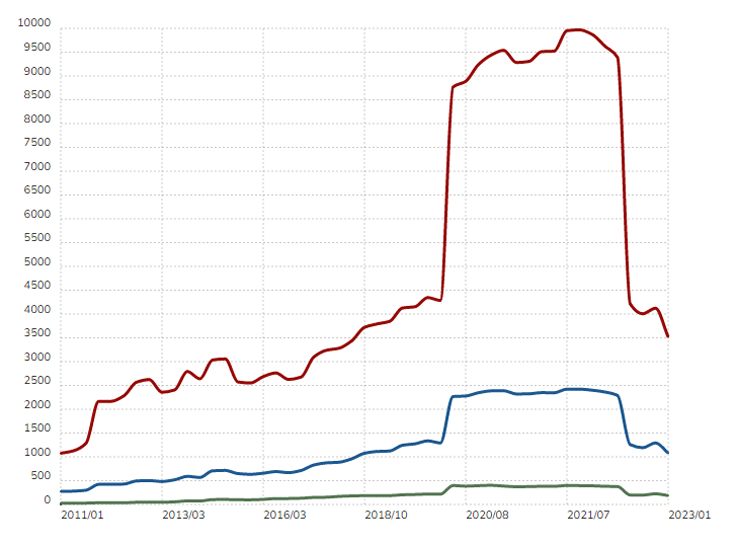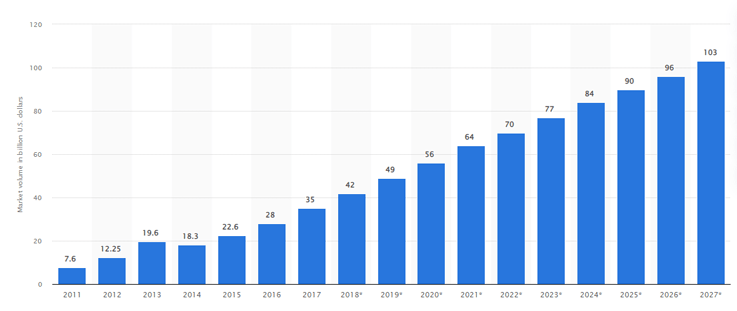Python is popular among businesses due to its ease of use and high-level capabilities. Python programming language may be used by developers to create a wide range of applications, from web apps to games and even machine learning. Python’s adaptability as an all-purpose programming language has been shown over and again by providing answers to numerous business difficulties.
Python has become a popular programming language for modern enterprises for good reason. Companies that use Python are frequently global in scale because of its versatility and dexterity. Its adaptability and flexibility make it useful in a wide range of industries, from finance and healthcare to technology and marketing. In this post, we’ll look at why Python has become such a popular programming language for businesses. To gain a deeper understanding
What is Python?
Python is an object-oriented, dynamically semantic, high-level, interpreted programming language. Rapid mobile app development and a scripting language bring existing components of Python together and find its high-level built-in data structures, coupled with dynamic type and dynamic binding, which makes Python particularly appealing. Python’s simple syntax promotes readability, which lowers the expense of software maintenance. Python is a scalable and popular programming language, BuiltWith studies show that around 826,274 websites are using Python. The graph below shows you the teal image of the popularity of Pything.

Image Source:- BuiltWith
This programming language support for modules and packages promotes the modularity of programs and the reuse of code. Both the comprehensive standard library and the Python interpreter are freely distributable and are accessible in source or binary form for all popular systems. Python programs are simple to debug since a segmentation failure is never caused by a bug or incorrect input. Instead, the interpreter raises an exception when it finds a mistake. The interpreter prints a stack trace if the application doesn’t catch the exception.
Setting breakpoints, evaluating arbitrary expressions, inspecting local and global variables, stepping through the code one line at a time, and other features are all possible with a source-level debugger. Python’s ability to perform introspection is demonstrated by the debugger, which is developed in Python. On the other hand, adding a few print statements to the source code is frequently the easiest way to debug a program due to the short edit-test-debug cycle.
What Can You Do With Python?
You might be wondering what kinds of applications you can create with Python, and the short answer is almost anything. Python is incredibly powerful and versatile in terms of the types of applications that may be created, despite its simplicity and low learning curve. Here are just a few examples of Python-based software:
- Mobile app development
- Desktop applications
- Video games, including text-based, 2D side-scrollers, and 3D
- Database-driven software
- Web apps and cloud-based apps
- Operating Systems
- Programming languages
- Web frameworks
- Enterprise applications
- Business and finance applications
- Graphical User Interface (GUI) based software
- Data science and data analyst apps
- Software that relies on Artificial Intelligence (AI), Machine Learning (ML), and Deep Learning (DL)
- Virtual Reality (VR) and Augmented Reality (AR)
Reasons Why Big Brands Use Python
Python is widely used for a variety of purposes. Here’s a closer look at what makes it so adaptable and simple to use for coders.
- It’s easy to read and understand because of the simple syntax that it resembles. As a result, projects can be built and improved more quickly.
- It is flexible. From machine learning to web development, Python is useful for a wide range of projects.
- It’s user-friendly for beginners, making it popular among beginning programmers.
- As open source, it can be used and distributed without charge, even for profit.
- Python has a sizable and expanding library and module repository, which are libraries of code written by certain developers to enhance Python’s functionality.
- A sizable and vibrant community supports Python, adds to its collection of modules and libraries, and is a valuable resource for other programmers. Because of the large support network, finding a solution to a coding problem is usually not too difficult because it is likely that someone else has already come into the same issue.
Leading Companies Using Python
Python is a popular back-end programming language that many successful technology companies use for their websites. Here are 10 well-known websites that were created with Python.
1. Google
Due to its involvement in so many online services, including Search, Android, Youtube, Stadia, and numerous others, Google is one of the largest technology companies in the world. Many core languages, including Python, Java, and Golang, are frequently present in a tech stack of this size, with Python receiving the greatest funding and attention. Since Python is concise and generally quick to maintain, it enables swift deployments across a wide range of Google applications, which is why the company chose it early on and still does today. The usage of projects including robots, artificial intelligence, machine learning, and the search engine are examples.
2. Quora
Every day, hundreds of questions are submitted on the popular question-and-answer website Quora, where some of the most creative people in the world respond. Python was chosen by Quora because of its efficiency, speed, and usability. Tornado, Pypy, and many other Python libraries are used by Quora. Python does not have type-checking, but Quora got around this by writing exhaustive unit tests. They chose Python over the other two contenders, C#, Java, and Scala, due to advantages including shorter development times, higher scalability, developer friendliness with better code readability, and the availability of many libraries.
3. Instagram
Instagram is a popular photo- and video-sharing network that employs Python to maximize operational effectiveness utilizing the well-known Python framework Django. The simplicity and dependability of the Django framework served as the inspiration for this, the most comprehensive implementation to date. The developers at Instagram, who also appear to prefer Python over PHP as their preferred base programming language, didn’t find the performance benefits of PHP to be convincing enough. Instagram has even transitioned from Python 2 to Python 3 over the course of ten months, demonstrating how impressed the brand is with Python.
4. Facebook
Facebook has changed a lot since it emerged as the first social media platform, igniting the market and dominating it. The use of Python in its technology stack is one of the causes of this. Facebook frequently donates bug patches and new features to the Python development community for the platform’s enhanced functioning. In 2023, it will be one of the largest businesses using Python. PHP and C++ are also part of Facebook’s technology stack.
5. Amazon
The platform of Amazon, a well-known online retailer, uses Python in a number of places. In order to monitor customer purchasing behavior and make recommendations, Amazon’s product and deal recommendation engine makes use of artificial intelligence and machine learning. Data management technology was necessary for Amazon because of the vast volume of data it handles. Python stepped in thanks to its excellent scalability and capacity for seamless integration with other platforms like Hadoop. Another illustration of how Amazon uses Python for a range of purposes, such as machine learning and automation in AWS resources, is Jupyter notebooks.
6. Uber
At its most fundamental level, Python, along with Node.js, Java, and Go, is used by Uber, a global corporation that lets you arrange journeys to your preferred locations. The business logic and all calculations, including the intermediate and top levels, like calculating ETA, ride fares, geo-locations, and demand and supply, are still primarily powered by Python. Uber uses Python and Tornado together, but frequently switches to Go in order to get higher concurrency throughput. As well as using Jupyter notebooks for all data analytics tasks, Uber also creates visualization frameworks for Python, R, and Shiny. Uber makes the most of Python’s outstanding libraries and is one of the most intelligent Python users.
7. Dropbox
Dropbox is a firm offering online file-sharing and storage, and the bulk of its desktop clients are powered by Python. Python’s creator, Guido van Rossum, was convinced to join the Dropbox team and aid in the platform’s development because Dropbox was so impressed with it. The business provides a Python SDK to developers who wish to integrate it into their Python project, despite the fact that it is proprietary, demonstrating their confidence in the platform. According to Dropbox developers, Python is used the most frequently for writing server-side programming.
8. Spotify
Python is also used to create Spotify, the most well-known music streaming service on the internet. It’s simple to see why Python was a perfect fit in this situation. Furthermore, since everyone wants their music listening experience to be intuitive, its speed and simplicity make it the perfect medium for this medium in particular. Particularly intriguing are Spotify’s Radio and Discover services, which utilize algorithms to recognize users’ musical inclinations and direct them toward new music.
9. Netflix
Netflix is another Python-based app that has become a popular destination for people all over the world to watch movies and TV shows. Python is used throughout the content lifecycle, from determining which content to fund to running the CDN (Content Delivery Network) that feeds the final movie to 148 million users. While Netflix engineers are free to use whatever language they like, the majority of them prefer to write in Python. The reasons for this preference for Python include its standard library, a large catalog of third-party libraries, simplicity, and an active development community.
10. Reddit
Reddit, one of the largest microblogging websites and the self-proclaimed first page of the internet, is the place to go if you want to get knowledge about anything. It has millions of users and billions of subjects. Reddit largely relies on Python and its vast library collection, progressively building a highly customized variant of each module accepted.
Estimated Growth Of Python
The popularity of Python has increased dramatically in recent years. According to Github, Python usage on GitHub climbed by 22.5% in 2022 compared to the previous year. There were allegedly somewhat more than 7 million Python developers as of September 2018. Its number increased to significantly more than 8 million by April 2019. There was a notable rise in people contributing to open-source projects as a result of the widespread adoption of lockdown legislation, and Python usage almost doubled. Market share for Python has grown dramatically over the past few years, and analysts predict that the trend will continue. By 2027, it is anticipated that the industry for big data analytics would be worth $103 billion, the image below gives you clear insights into the growth:

Image Source:- Statista
A Quick Peek into the Driving Growth of Python
A wide range of variables is contributing to Python’s sustained popularity. The first is very probably attributable to some of the world’s largest corporations electing to utilize Python as their primary programming language. This increases the number of job possibilities and Python courses available online. It’s also a result of data analytics becoming a top priority for many organizations. Companies are searching for data scientists to use programming languages such as Python to make sense of this data and assist drive business success.
Other major factors that have contributed to the increased use of Python include the following:
1. AI & Machine Learning
Currently, machine learning is a hot topic in the IT sector. There are many uses for machine learning, from utilizing Siri on your phone to Google’s predictive search. Moreover, Python is currently a well-liked language among web developers for simplifying this procedure.
2. Data Analytics
The single most significant reason why people are switching to Python, according to estimates, is the development of 17MB of data by each person on the earth every second. There has never been a more pressing need to manage and organize this data, and Python data analytics makes a lot of sense.
3. Application Development
Python is a strong programming language that you can use to create a wide variety of applications. Python is an excellent choice for applications spanning from blockchain to video and audio.
4. Development of a Website
Python’s many libraries and frameworks, including Django and Flask, as well as its versatility make it a great choice for web developers. Also, Reddit and Spotify use these three frameworks.
5. Visualization of Data
Python is an excellent choice for data visualization, whether you want to create simple visualizations or something more interactive. Data visualization with Python provides a wide range of possibilities due to the large number of modules available, allowing you to transform your data into relevant insights.
In a Nutshell
Python has emerged as a preferred programming language for developing applications among several big names in the industry. Its simplicity, versatility, and extensive range of libraries have attracted big brands to harness its power for their application development needs. Python’s ability to handle complex tasks, scalability, and rapid development cycle has proven to be advantageous for these brands, enabling them to deliver robust and efficient applications to their users. If you are also considering Python for your application development needs, it is important to choose the best Python web development company for development. By partnering with an experienced and reputable development company, you can leverage Python’s capabilities to create high-quality, scalable, and feature-rich applications that align with your business goals. With the right expertise and support, your application can stand out in the market, drive user engagement, and propel your business forward in the digital landscape.





